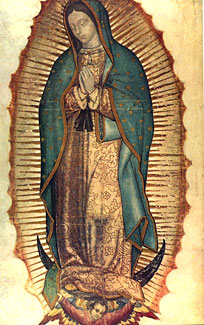She first allegedly appeared on Tepeyac Hill near Mexico
City nearly five centuries ago, on Dec. 12, 1531. Now
she appears yearly in almost every city, town, village
and hamlet in Mexico in the form of paintings, statues
or living representatives during the December processions
and pilgrimages commemorating the legendary encounter
between the Virgen de Guadalupe
and the Indian Juan Diego all those years ago.
Her image has become iconic, revered by the entire
country.  Several
armies fighting in Mexico have used it as their symbol.
Miguel Hidalgo in the Mexican War of Independence and
Emiliano Zapata during the Mexican Revolution carried
flags bearing the image of this icon. The first Mexican
president changed his name to honor the symbol.
Several
armies fighting in Mexico have used it as their symbol.
Miguel Hidalgo in the Mexican War of Independence and
Emiliano Zapata during the Mexican Revolution carried
flags bearing the image of this icon. The first Mexican
president changed his name to honor the symbol.
The enormous basilica of Nuestra Senora de Guadalupe
in Mexico City is the reliquary that enshrines the famous
relic. Yearly, over ten million pilgrims come to venerate
the tilma (or apron) of Juan Diego, which shows the
icon of Our Lady of Guadalupe, making the basilica the
second most visited Catholic site in the world, next
to the Vatican.
Its location, on the hill of Tepeyac, was a place of
great sanctity long before the arrival of the Spanish
in the New World. In pre-Hispanic times, Tepeyac had
been the site of a temple dedicated to an Earth and
fertility goddess called Tonantzin. Her full
Aztec name, Tonantzin Tlalli, means "Our
Revered Mother Earth." Tonantzin is believed to
be a manifestation of the Earth Mother, known as Coatlicue,
the mother of all living things, who was conceived by
immaculate and miraculous means. She was also the one
who decided the length of life. To the Mexica, the earth
was both mother and tomb, the giver of life and the
devourer. Human sacrifice and harsh physical penance
were used to appease this goddess. Tonantzin, or Little
Mother, patron of childbirth, had a devout following.
The Aztecs mourned their goddess and felt threatened
and endangered by the profanation and razing of her
temple by the Spaniards.
Viewing this extraordinary yearly pageant, it's difficult
to separate what is Christian and what is indigenous
in the rituals being performed. Nuestra Senora
Click
the first image for a Slide Show |
|
|
|
|
|
|
de Guadalupe is Mexico's patron saint, and
her image adorns churches and altars, house fronts and
interiors, taxis and buses, bull rings and gambling
dens, restaurants and houses of ill repute. The basilica
of Guadalupe is a place of extraordinary vitality and
celebration. On major festival days, such as the anniversary
of the apparition on December 12th, the atmosphere of
devotion created by the hundreds of thousands of pilgrims
is truly electrifying.
This year in San Felipe, 2009, the annual procession
of Nuestra Senora de Guadalupe changed its
habitual format and replaced a lifeless icon of past
years with a living child dressed as the Virgen.
The small passion play moved slowly along Av. Chetumal
on its way to la Capilla, which houses the venerative
candles and icon of the Virgen.